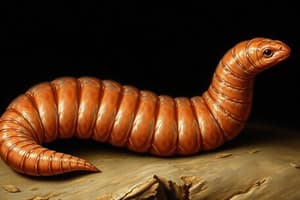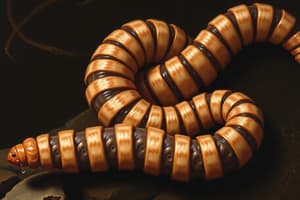Podcast
Questions and Answers
What is a distinguishing feature of the class Polychaeta?
What is a distinguishing feature of the class Polychaeta?
- Lack of sexual dimorphism
- Terrestrial habitat
- Presence of parapodia (correct)
- No distinct head region
Which characteristic is NOT true for the class Oligochaeta?
Which characteristic is NOT true for the class Oligochaeta?
- They are usually terrestrial
- They are hermaphroditic
- They have a distinct head (correct)
- They lack parapodia
Which of the following best describes the reproductive strategy of earthworms in the class Oligochaeta?
Which of the following best describes the reproductive strategy of earthworms in the class Oligochaeta?
- Few eggs laid with external fertilization
- Strictly self-fertilization
- Protandrous cross-fertilization (correct)
- Asexual reproduction only
What is a key feature of the class Hirudinea?
What is a key feature of the class Hirudinea?
What role do earthworms play in soil health?
What role do earthworms play in soil health?
Which organisms are classified under the class Hirudinea?
Which organisms are classified under the class Hirudinea?
Which statement accurately describes the larvae of Polychaeta?
Which statement accurately describes the larvae of Polychaeta?
What feature do Oligochaeta and Hirudinea share during reproduction?
What feature do Oligochaeta and Hirudinea share during reproduction?
What type of symmetry do annelids exhibit?
What type of symmetry do annelids exhibit?
What is the main advantage of segmentation in annelids?
What is the main advantage of segmentation in annelids?
Which system in annelids is responsible for gas exchange?
Which system in annelids is responsible for gas exchange?
What type of skeleton do annelids possess?
What type of skeleton do annelids possess?
What defines the fate of the blastopore in annelids?
What defines the fate of the blastopore in annelids?
Which structure separates the segments in annelids?
Which structure separates the segments in annelids?
What is one of the advantages of having a coelom in annelids?
What is one of the advantages of having a coelom in annelids?
What type of nervous system is found in annelids?
What type of nervous system is found in annelids?
Flashcards
Annelids
Annelids
Segmented worms, bilaterally symmetrical animals with a true body cavity (coelom).
Segmentation (Annelids)
Segmentation (Annelids)
Repetitive segments (metameres) along the body of annelids, each with similar structures.
Metamere
Metamere
A segment in an annelid's body.
Coelom
Coelom
Signup and view all the flashcards
Coelomate
Coelomate
Signup and view all the flashcards
Advantages of Segmentation
Advantages of Segmentation
Signup and view all the flashcards
Advantages of Coelom
Advantages of Coelom
Signup and view all the flashcards
Hydrostatic skeleton
Hydrostatic skeleton
Signup and view all the flashcards
Annelids: Polychaeta
Annelids: Polychaeta
Signup and view all the flashcards
Annelids: Oligochaeta
Annelids: Oligochaeta
Signup and view all the flashcards
Annelids: Hirudinea
Annelids: Hirudinea
Signup and view all the flashcards
Earthworm's role in soil
Earthworm's role in soil
Signup and view all the flashcards
Annelid - Bisexuality
Annelid - Bisexuality
Signup and view all the flashcards
Parapodia
Parapodia
Signup and view all the flashcards
Clitellum
Clitellum
Signup and view all the flashcards
Protantrous
Protantrous
Signup and view all the flashcards
Study Notes
Phylum Annelida - The Segmented Worms
- Bilateria, triploblastic, coelomates
- These worms are segmented
- Exhibit metameric segmentation (serial repetition) which aids in flexibility and movement
- Each segment is called a metamere or somite
- The coelom is a true body cavity which develops by splitting of mesoderm
- Advantages of the coelom: definite shape, protects from mechanical shocks, cushions internal organs and acts as a hydrostatic skeleton for locomotion in soft-bodied animals
- Exhibit a complete digestive system with a mouth and anus
- Have a closed circulatory system with blood that is red and contains hemoglobin
- Have a well-developed nervous system. The nervous system consists of a simple brain, a ventral nerve cord and a series of ganglia.
- Their respiratory system uses diffusion through the skin into the blood capillaries.
- The excretory system typically consists of a pair of metanephridia per segment
- Some are predators and some are ectoparasites
- Some species are aquatic, some are terrestrial and some are burrowers
- Examples of annelids include: Nereis, Earthworms (Lumbricus terrestris and other species), leeches.
Classification of Annelids
- Polychaeta: mostly marine, free living, many setae on fleshy, lateral outgrowths called parapodia, well-developed appendages, separate sexes, free-swimming trochophore larva. Examples: Sabella (peacock worm), Nereis
- Oligochaeta: usually terrestrial, burrowers, few setae without parapodia, no distinct head appendages, hermaphrodites, eggs deposited in a cocoon, development is direct. Example: Pheretima (earthworm)
- Hirudinea: ectoparasites, some are free living predators, dorso-ventrally flattened, no setae, clitellum present only during reproduction, two suckers (anterior and posterior). Example: Hirudinaria (common Indian leech).
Importance of Annelids
- Soil health and agriculture: Earthworms burrow through the soil, improving aeration and water infiltration, and increasing soil fertility.
- Nutrient recycling: Earthworms break down organic matter, facilitating nutrient cycling. Their castings are rich in nutrients which are good for organic farming.
- Fisheries: Annelids are used as bait in fishing.
- Medicinal uses: Medicinal leeches (e.g., Hirudo medicinalis) are used in medical treatments, particularly in plastic and reconstructive surgery, due to their ability to promote blood circulation and produce anticoagulant chemicals that prevent blood clots.
Specialized Features in Annelids
- Crop: store food
- Gizzard: grind food
- Pharynx: connects the mouth with the digestive tract
- Intestine: where nutrients are absorbed.
- Septa: walls that partition the coelom
- Bristles/seta: used for locomotion in some species
- Parapodia: lateral outgrowths of the body wall found in some species
- Clitellum: a thickened region of the body which is involved in reproduction
- Specialized glands are present , and organs such as the salivary glands, also in medicinal leeches for example
Studying That Suits You
Use AI to generate personalized quizzes and flashcards to suit your learning preferences.




